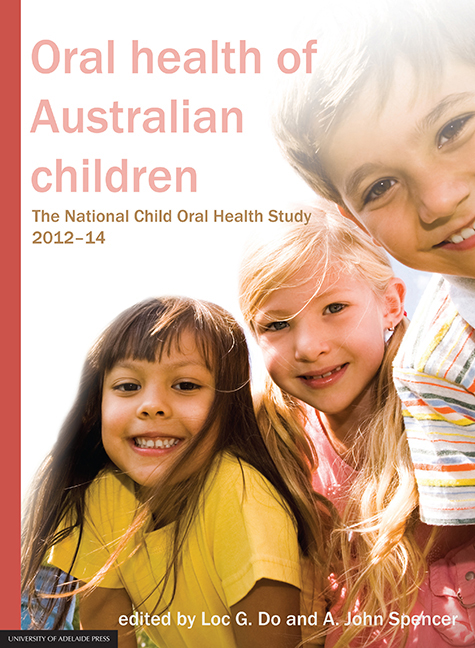Book contents
- Frontmatter
- List of Contributors
- Contents
- Preface
- Executive Summary
- 1 Children's oral health – assessing and improving oral health
- 2 Measuring child oral health and its influences
- 3 Data weighting, consideration and estimation procedures
- 4 Measuring representativeness of the study participants
- 5 Children's oral health status in Australia, 2012–14
- 6 Patterns of dental services use by Australian children
- 7 Australian children's oral health behaviours
- 8 Australian children's general health behaviours
- 9 Social gradients in child oral health
- 10 Oral health status and behaviours of Indigenous Australian children
- 11 Trends in child oral health in Australia
- 12 Interpretation of findings and a way forward to improving oral health and dental care
- 13 Appendix
- State and territory survey personnel
- Symbols
- Abbreviations
- Place names
- Glossary
- List of tables
- List of figures
4 - Measuring representativeness of the study participants
Published online by Cambridge University Press: 05 September 2017
- Frontmatter
- List of Contributors
- Contents
- Preface
- Executive Summary
- 1 Children's oral health – assessing and improving oral health
- 2 Measuring child oral health and its influences
- 3 Data weighting, consideration and estimation procedures
- 4 Measuring representativeness of the study participants
- 5 Children's oral health status in Australia, 2012–14
- 6 Patterns of dental services use by Australian children
- 7 Australian children's oral health behaviours
- 8 Australian children's general health behaviours
- 9 Social gradients in child oral health
- 10 Oral health status and behaviours of Indigenous Australian children
- 11 Trends in child oral health in Australia
- 12 Interpretation of findings and a way forward to improving oral health and dental care
- 13 Appendix
- State and territory survey personnel
- Symbols
- Abbreviations
- Place names
- Glossary
- List of tables
- List of figures
Summary
This Survey gathered information from a representative sample of the Australian child population aged 5–14 years to describe the oral health status of the population and factors related to use of dental services and dental behaviours, as well as associated individual, family, and community factors such as the sociodemographic characteristics of the child's household.
Surveys provide a means of measuring a population's characteristics, self-reported and observed behaviour, and needs. Unlike a census, where all members of a population are studied, sample surveys gather information from only a portion of a population of interest. In a statistically valid survey, the sample is objectively chosen so that each member of the population will have a known non-zero chance of selection. Only then can the results be reliably projected from the sample to the population.
Surveys, however, are not exempt of errors (or bias), which can occur when some segments of the population do not participate in the survey. As not all Australian children were included in this Survey, there is potential that the sample does not accurately represent the population of interest.
Errors due to sampling depend on the sample selection strategy and can be measured statistically. Variability inherent to the sampling process is expressed using the 95% confidence interval. On the other hand, non-sampling error or bias is more problematic because it is more difficult to measure and control. Bias due to non-participation occurs when the participants differ from the non-participants or the targeted population in one or more characteristics. The potential for bias due to non-participation or non-response can be explored by examining key sociodemographic characteristics of the Survey sample, and comparing them with known characteristics of the target population.
As outlined in Chapter 3, this Survey employed rigorous sampling procedures to achieve a representative sample of the Australian child population aged 5–14 years. The procedures used to derive survey weights for this Survey reflect the standards of best practice for weighting complex survey data, and are procedures used by leading statistical agencies. Procedures used to derive survey weights ensure valid estimates and inferences of the target child population can be made. The methodologies employed in the Survey will minimise any potential bias, which will be assessed in this chapter.
- Type
- Chapter
- Information
- Oral Health of Australian ChildrenThe National Child Oral Health Study 2012-14, pp. 48 - 85Publisher: The University of Adelaide PressPrint publication year: 2016



